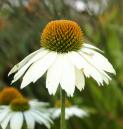BERBERIS. (OREGON GRAPE.)—The rhizome and roots of species of the section Odostemon (Mahonia) Rafinesque of the genus Berberis Linné, without the admixture of more than 5 per cent. of the overground parts of the plant or other foreign matter. Berberis without the bark should be rejected.
In more or less knotty irregular pieces of varying length and from 3 to 50 mm. in diameter; bark from 0.5 to 2 mm. thick; wood yellowish, distinctly radiate, with narrow medullary rays, hard and tough; rhizome with a small pith; odor distinct; taste bitterish.
Powder.—Yellowish-brown composed chiefly of fragments of wood fibers associated with a few tracheae and medullary rays. Wood fibers yellow with large simple transverse pores; tracheae chiefly with bordered pores occasionally reticulate; starch grains single or 2 to 3 compound. The individual grains are irregularly spherical.
CONSTITUENTS.—Contains three alkaloids, berberine, oxycanthine and berbamine; the two latter are white. Used as tonic and alterative in doses of 8 to 30 gr. (0.5 to 2 Gm.). (Fluidextractum U.S.P. 1900.)

